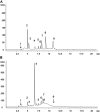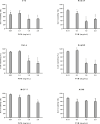Polypodium vulgare L. (Polypodiaceae) as a Source of Bioactive Compounds: Polyphenolic Profile, Cytotoxicity and Cytoprotective Properties in Different Cell Lines
- PMID: 34603041
- PMCID: PMC8482143
- DOI: 10.3389/fphar.2021.727528
Polypodium vulgare L. (Polypodiaceae) as a Source of Bioactive Compounds: Polyphenolic Profile, Cytotoxicity and Cytoprotective Properties in Different Cell Lines
Abstract
Pteridophytes, represented by ferns and allies, are an important phytogenetic bridge between lower and higher plants. Ferns have evolved independently of any other species in the plant kingdom being its secondary metabolism a reservoir of phytochemicals characteristic of this taxon. The study of the potential uses of Polypodium vulgare L. (Polypodiaceae) as medicinal plant has increased in recent years particularly when in 2008 the European Medicines Agency published a monograph about the rhizome of this species. Our objective is to provide scientific knowledge on the polar constituents extracted from the fronds of P. vulgare, one of the main ferns of European distribution, to contribute to the validation of certain traditional uses. Specifically, we have characterized the methanolic extract of P. vulgare fronds (PVM) by HPLC-DAD and investigated its potential cytotoxicity, phototoxicity, ROS production and protective effects against oxidative stress by using in vitro methods. The 3T3, HaCaT, HeLa, HepG2, MCF-7 and A549 were the cell lines used to evaluate the possible cytotoxic behaviour of the PVM. HPLC-DAD was utilized to validate the polyphenolic profile of the extract. H2O2 and UVA were the prooxidant agents to induce oxidative stress by different conditions in 3T3 and HaCaT cell lines. Antioxidant activity of in vitro PVM in 3T3 and HaCaT cell lines was evaluated by ROS assay. Our results demonstrate that PVM contains significant amounts of shikimic acid together with caffeoylquinic acid derivatives and flavonoids such as epicatechin and catechin; PVM is not cytotoxic at physiological concentrations against the different cell lines, showing cytoprotective and cellular repair activity in 3T3 fibroblast cells. This biological activity could be attributed to the high content of polyphenolic compounds. The fronds of the P. vulgare are a source of polyphenolic compounds, which can be responsible for certain traditional uses like wound healing properties. In the present work, fronds of the common polypody are positioned as a candidate for pharmaceutical applications based on traditional medicine uses but also as potential food ingredients due to lack of toxicity at physiological concentrations.
Keywords: cytoprotection; cytotoxicity; ferns; medicinal plants; polyphenols; polypody.
Copyright © 2021 Farràs, Mitjans, Maggi, Caprioli, Vinardell and López.
Conflict of interest statement
The authors declare that the research was conducted in the absence of any commercial or financial relationships that could be construed as a potential conflict of interest. The handling editor declared a past co-authorship with several of the authors FM, GC.
Figures







References
-
- AEMPS (2013). PROSPECTO: INFORMACIÓN PARA EL PACIENTE Difur 120 Mg Cápsulas Duras. Spain: Agencia Española de Medicamentos y Productos Sanitarios (AEMPS), 4.
-
- Arai Y., Shiojima K., Ageta H. (1989). Fern Constituents: Cyclopodmenyl Acetate, a Cycloartanoid Having a New 33-carbon Skeleton, Isolated from Polypodium vulgare . Chem. Pharm. Bull. 37, 560–562. 10.1248/cpb.37.560 - DOI
LinkOut - more resources
Full Text Sources

